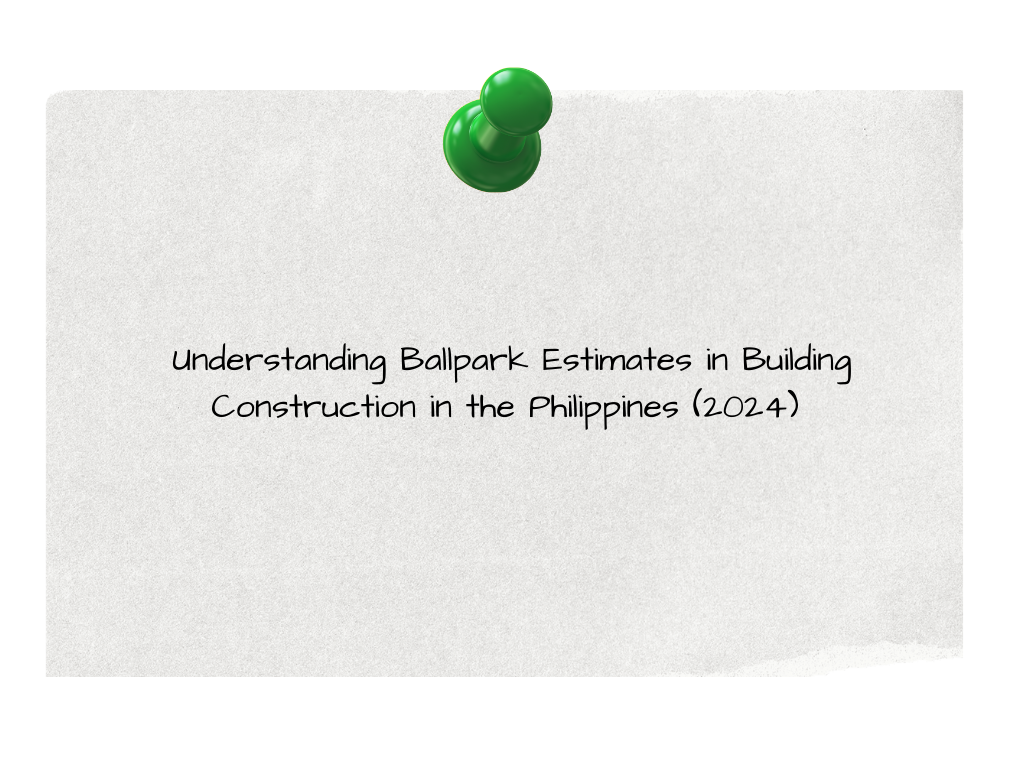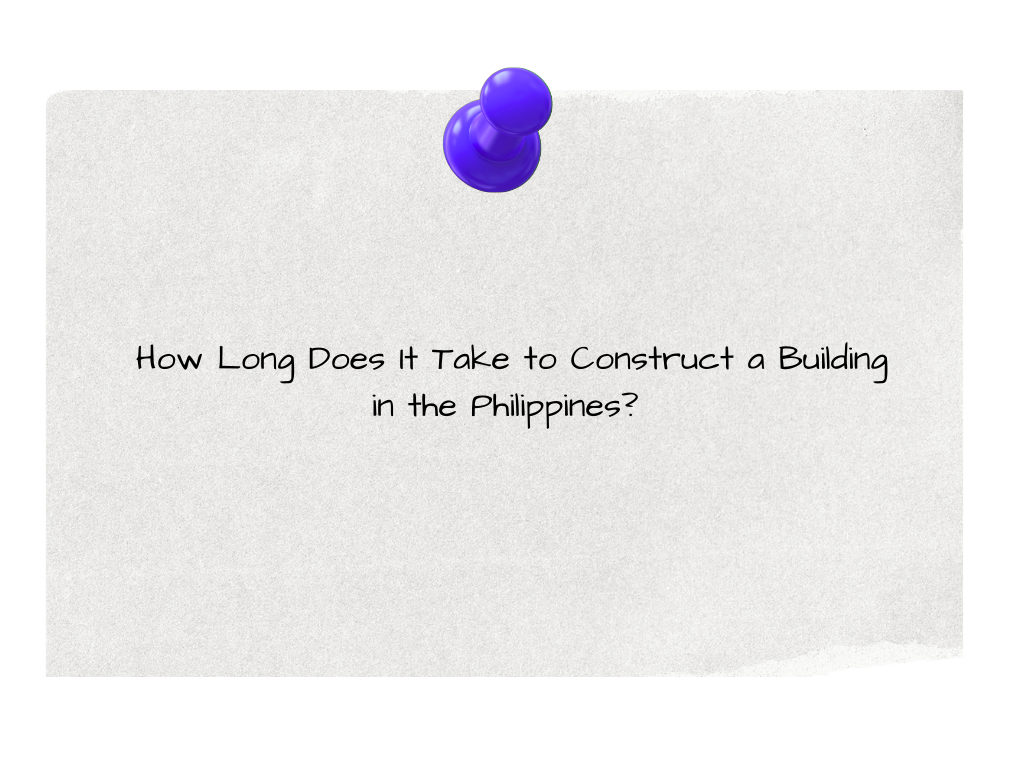One of the initial questions that come up when planning a construction project in the Philippines is, “How much will the construction project cost?” Although the exact cost will be determined by many factors, a ballpark estimate can at least provide a general starting point. A ballpark estimate is a quick calculation of the full project cost that a home or business owner can use to determine the profitability of a project at the very start of the budgeting and planning stage.
In 2024, construction costs of buildings in the Philippines are influenced by several factors, such as the type of building, the location of the project, the materials used, and the current economic conditions. In the paper, we will elaborate what a ballpark estimate is, what are the factors affecting it, and how will you use it as a successful person in your planning.
What is a Ballpark Estimate?
A ballpark estimate is a general cost estimate calculated for a construction project that is based on just a few pieces of information, usually given at the beginning of the planning stage. This is the money of the house that can be used to get an initial idea of cost exposure before signing a definitive team or calling a formal bid.
It is crucial to acknowledge the fact that a guesstimate is not a precise number. It is designed to provide a general idea of the building’s construction cost ranges, and the magnitude of the range from +20% to -30% depends on various factors like location, scope of the project, and other factors.
Ballpark estimates are typically applied in the following contexts:
- Budgets: Building officials or homeowners have the final say to the project only when they know the budget if they can afford the project.
- Feasibility Studies: This is a plan that will provide potential ideas to financers and stakeholders in the early fathering level about the financial feasibility of a project.
- Comparative Cost Estimation: They serve, along with other findings, as a basis of comparison of various building methods and types.
Key Factors Affecting Ballpark Estimates in the Philippines
There are several factors to think about when you are preparing a guesstimate for the construction of the building in the Philippines. These issues pinpoint the conversion cost (or other relevant data) and ultimately gear the nature of the total budget for a project.
1. Type of Building
The kind of building that is being constructed is a vital factor that affects costs. The designs and materials needed are also different for residential, commercial, and industrial buildings, which of course make the overall costs to vary. For example:
- Residential Buildings: Homes that are part of a living setup that may be single-family, condo or townhouse style properties. The overall design of the structure, materials used, and the number of stories, all contribute to the cost.
- Commercial Buildings: Offices, malls, mixed-use developments are more complicated than other buildings and usually, therefore, have to use specialized materials and complicated mechanical, electrical, and plumbing (MEP) systems. Hence, it is more of high-costs as far as commercial construction is concerned.
- Industrial Buildings: Warehouses are designed in such a way that it provides enough space for storage. Component factories and plants probably have simple designs, but because of their large scale or special needs, the cost of land may be higher as structural engineering may need to be more rugged.
- Institutional Buildings: These infrastructure developments usually involve the addition of devices for people that otherwise wouldn’t be safe. Any special aspect (e.g., accessibility, safety standards, or specialized facilities) that is more than the general requirements for hospitals, schools, or government offices will add to the construction cost.
2. Location
Where the construction takes place has a direct impact on costs. Location affects land acquisition, labor availability, material transportation, and local regulations. Key location factors include:
- Metro Manila vs. Provincial Areas: The costs of construction are generally higher in Metro Manila due to the higher price of land, labor, and material supply. However, a small portion of costs might be saved by shifting the construction project to a province where the cost of land is lower, the supply of labor is cheap and the price of materials is equal to Metro Manila cost.
- Urban vs. Rural Areas: Urban spaces, in general, have more infrastructure (e.g., streets, sewer systems, utilities), which may add to the project cost. In rural areas, the land price may be lower, but the transport expenses are still there.
3. Materials and Finishes
The choice of materials used in construction is one of the most significant factors influencing the ballpark estimate. Premium materials, such as imported tiles, marble finishes, or high-end glass windows, will substantially raise the overall cost. Other low-cost materials like locally sourced ones can be used to make the project economical.
For example:
- Basic Finishes: A usual rural house with basic finishes such as cement flooring, wooden panels, and also paint the walls will generally cost about PHP 25,000 up to PHP 40,000 per square meter within Metro Manila.
- High-End Finishes: A mansion or a commercial establishment that utilizes upper-class materials like granite, for example, can cost a minimum of PHP 50,000 per square meter up to of PHP 75,000 per square meter or even more.
4. Labor Costs
Labor is another key aspect in defining the differences in cost between various regions. In the case of densely populated areas, more skills are maybe required, and thus, wages might be higher, whereas in rural or remote areas, labor prices could be lower.
5. Design Complexity
As mentioned, the intricacy of the design highly affects the cost of construction. A project with an absolutely perfect and complicated design, closed layouts, or new structural components will need more work by engineers, some special professional workers, and then usually more worker salary. The alternative is less intricate designs, which means a direct way of implementing them and thus these will most times be cheaper to construct.
For instance, a high-rise building or a commercial building with a complex shape and elevated technology would require you to give a higher slim guess than a normal single-family house with a standard floor design.
6. Construction Method and Technology
The construction method and the use of technology can be the to varying degrees, both can affect costs. Up-to-the-minutes technologies, for example, frame houses with modular modules or buildings where parts are assembled off-site then put together at the construction site, are options that can produce homes quickly and inexpensively, though they may not be viable for every building type. However, the use of traditional construction methods, which are more physically demanding, is sometimes necessary and can even be cheaper in some areas.
7. Project Timeline
The estimated cost of the project also depends on the project timeline. Besides that, fast-track projects or projects with the use of overtimed work to meet deadlines will need someone to be given a higher wage or new team members brought in for the surplus of tasks.
Ballpark Estimates for Building Construction in the Philippines (2024)
As a very rough idea of the price range, we are presenting here the building construction ballpark estimates for the Philippines by 2024. These figures are related to different levels of construction quality and design complexity:
- Low-Cost Residential (Standard Quality):
- PHP 20,000 to PHP 30,000 per square meter
- Typically used for basic residential houses with minimal finishes.
- Mid-Range Residential:
- PHP 35,000 to PHP 50,000 per square meter
- Used for more detailed design and better materials (e.g., premium tiles, solid wood doors).
- High-End Residential:
- PHP 50,000 to PHP 75,000 per square meter or even more
- Luxury homes are the major functions, and unique features
- Commercial Buildings (Offices, Malls, Mixed-Use):
- PHP 40,000 to PHP 70,000 per square meter
- The costs of the file are different from one building to another and they depend on the materials used.
- Industrial Buildings (Factories, Warehouses):
- PHP 20,000 to PHP 35,000 per square meter
- Most commonly, industries prefer simpler design, but the costs are inclined by the size and the place of the locations.
On the whole, design complexity is less significant as a cost factor during the schematic design phase, thus the magnitude of the building and its location play the primary roles in the expense.
Conclusion
The so-called “ballpark estimate” applies, therefore, it is not guaranteed in the first engineering phase still it’s wonderful tool to analyses the needed amount of funds for the project. The actual expense may be altered as a result of changes based on different factors while the detailed planning process continues.
To obtain a more accurate estimate, it is advisable to consult a registered architect or constructor who can develop a comprehensive cost listing that matches your specific project needs. Realizing the forces that reduce the construction expenditure, you shall be more successful in the budgeting process and be feeble in the expectations of your real estate property in the Philippines.




One thought on “Understanding Ballpark Estimates in Building Construction in the Philippines (2024)”